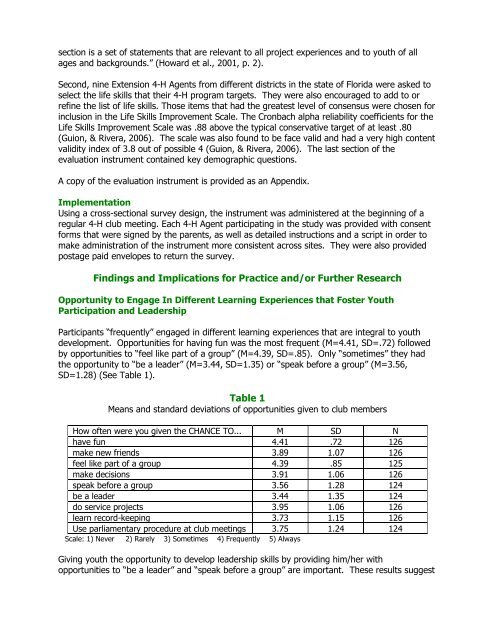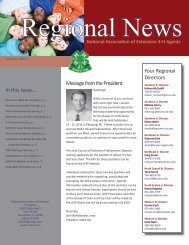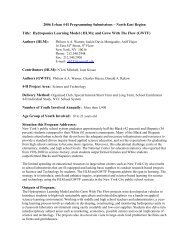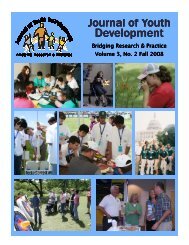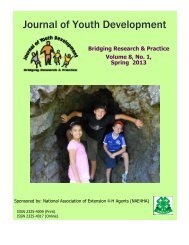Winter 2008 - Vol. 3 No. 3 - National Association of Extension 4-H ...
Winter 2008 - Vol. 3 No. 3 - National Association of Extension 4-H ...
Winter 2008 - Vol. 3 No. 3 - National Association of Extension 4-H ...
- No tags were found...
Create successful ePaper yourself
Turn your PDF publications into a flip-book with our unique Google optimized e-Paper software.
section is a set <strong>of</strong> statements that are relevant to all project experiences and to youth <strong>of</strong> allages and backgrounds.” (Howard et al., 2001, p. 2).Second, nine <strong>Extension</strong> 4-H Agents from different districts in the state <strong>of</strong> Florida were asked toselect the life skills that their 4-H program targets. They were also encouraged to add to orrefine the list <strong>of</strong> life skills. Those items that had the greatest level <strong>of</strong> consensus were chosen forinclusion in the Life Skills Improvement Scale. The Cronbach alpha reliability coefficients for theLife Skills Improvement Scale was .88 above the typical conservative target <strong>of</strong> at least .80(Guion, & Rivera, 2006). The scale was also found to be face valid and had a very high contentvalidity index <strong>of</strong> 3.8 out <strong>of</strong> possible 4 (Guion, & Rivera, 2006). The last section <strong>of</strong> theevaluation instrument contained key demographic questions.A copy <strong>of</strong> the evaluation instrument is provided as an Appendix.ImplementationUsing a cross-sectional survey design, the instrument was administered at the beginning <strong>of</strong> aregular 4-H club meeting. Each 4-H Agent participating in the study was provided with consentforms that were signed by the parents, as well as detailed instructions and a script in order tomake administration <strong>of</strong> the instrument more consistent across sites. They were also providedpostage paid envelopes to return the survey.Findings and Implications for Practice and/or Further ResearchOpportunity to Engage In Different Learning Experiences that Foster YouthParticipation and LeadershipParticipants “frequently” engaged in different learning experiences that are integral to youthdevelopment. Opportunities for having fun was the most frequent (M=4.41, SD=.72) followedby opportunities to “feel like part <strong>of</strong> a group” (M=4.39, SD=.85). Only “sometimes” they hadthe opportunity to “be a leader” (M=3.44, SD=1.35) or “speak before a group” (M=3.56,SD=1.28) (See Table 1).Table 1Means and standard deviations <strong>of</strong> opportunities given to club membersHow <strong>of</strong>ten were you given the CHANCE TO... M SD Nhave fun 4.41 .72 126make new friends 3.89 1.07 126feel like part <strong>of</strong> a group 4.39 .85 125make decisions 3.91 1.06 126speak before a group 3.56 1.28 124be a leader 3.44 1.35 124do service projects 3.95 1.06 126learn record-keeping 3.73 1.15 126Use parliamentary procedure at club meetings 3.75 1.24 124Scale: 1) Never 2) Rarely 3) Sometimes 4) Frequently 5) AlwaysGiving youth the opportunity to develop leadership skills by providing him/her withopportunities to “be a leader” and “speak before a group” are important. These results suggest


